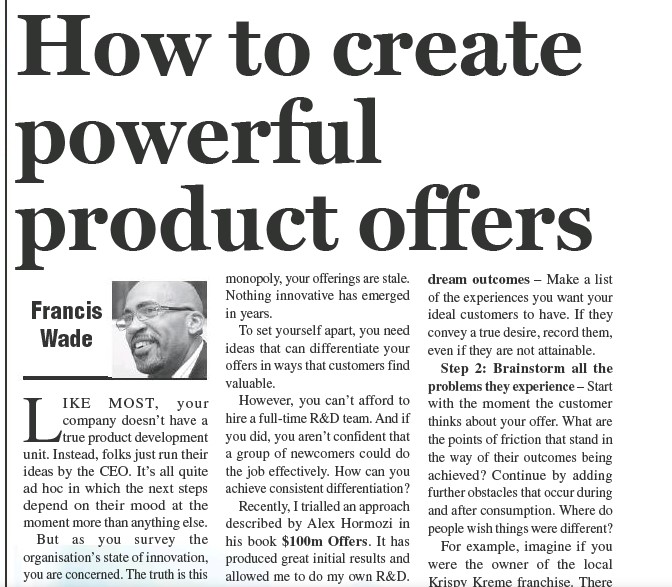Many companies lack a formal product development unit. Instead, ideas are casually pitched to the CEO, and the next steps depend on their mood at the moment. This approach often falls short in delivering consistent innovation, resulting in products and services that closely resemble competitors’ offerings. If you’re a monopoly, your products might become stale over time. To stand out, you need innovative ideas that provide real value to your customers.
The challenge? You may not have the resources to hire a full-time R&D team, and even if you could, you might not trust newcomers to handle the job effectively. So, how can you consistently set your offerings apart from the rest?
Recently, I experimented with an approach outlined by Alex Hormozi in his book, “$100m Offers.” This approach revolves around the customer experience and has yielded promising results. I highly recommend this method, as it takes an inside-out perspective. Let me walk you through the steps I followed, using a local example.
Step 1 – Envision Dream Outcomes
Start by listing the experiences you want your ideal customers to have. Even if some of these experiences seem unattainable, record them. The goal is to capture what your customers truly desire.
Step 2 – Identify Customer Pain Points
Think about the moment a customer considers your offering. What are the hurdles and obstacles preventing them from achieving their desired outcomes? Consider issues that arise during and after using your product or service. For instance, let’s imagine you own the Krispy Kreme franchise in Jamaica. If someone has never tried your donuts, what challenges might they face?
- Traffic around the store’s location is congested.
- There are long lines inside.
- The customer is on a diet.
- They don’t like overly sweet food.
- They had a bad experience with a competitor’s product.
This is just a starting point. Keep going until you’ve identified at least a hundred pain points for your offering. The more you list, the deeper you’ll delve into the customer experience, leading to more valuable insights than traditional surveys.
Step 3 – Propose Solutions for Each Problem
Address each pain point with a solution, expressed in the form of a “How to…” statement. For example, “I am on a diet” could be solved with “How to enjoy our product while sticking to your diet.”
But don’t stop there. Be thorough.
Step 4 – Design Strategies to Implement Solutions
Let your imagination run free in this step. Create offers, or “vehicles,” that correspond to each “How to…” solution from the previous step. Give these vehicles catchy, descriptive names that would grab your customer’s attention. Be comprehensive and include even those you may not intend to provide.
For example, considering the solution “How to enjoy our product while on a diet,” what could you name the corresponding vehicles to attract customers?
- The 47-Calorie Donut Hole
- The Perfect Donut for a Dieter’s Cheat Day (Help dieters plan effective cheat days with this brand.)
- Free Traffic Morsels (Offer complimentary pastries for people stuck in traffic.)
- Our Lowest-Ever Calorie/Fat Gram Donut (Give diet-conscious customers a guilt-free treat.)
- The Unsweet Spicy Donut (Appealing to dieters who prefer savory over sweet.)
This list took me just 10 minutes to create. You don’t need to be exceptionally creative; following this structured process can help you brainstorm at an impressive pace.
Step 5 – Evaluate and Prioritize Solutions
Assign two measures to each vehicle: its value to the customer and the cost to your business to offer it. Use these measures to rank your offers and establish a timeline for implementation.
In conclusion, these lists can jumpstart your innovation. Thanks to Alex Hormozi, these lightweight forms of R&D leverage the everyday experiences you’re already gathering.
This article appeared in an earlier form as a Jamaica Gleaner column.

